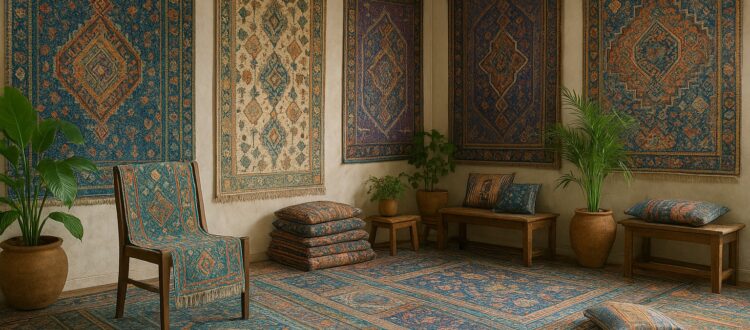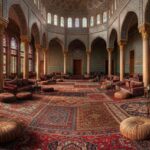Woven Stories: Tribal Rugs & Nomadic Carpets Around The World
Imagine a piece of art that not only adorns your floor but also tells a millennia-old story, whispered through intricate patterns and vibrant dyes. Woven by semi-nomadic and nomadic tribes, typically in erstwhile Central Asia, Caucasus, Anatolia, Persia and Kurdish enclaves, tribal rugs are extremely popular amongst collectors around the world.
Its origins date back to ancient times, and the Pazyryk carpet (unearthed in a Scythian tomb in Siberia), created around the 5th century BC, is known as the oldest surviving carpet in the world.
A textile born from the harsh beauty of mountain ranges, the vastness of deserts, and the deep-rooted traditions of communities living in harmony with nature. This is the magic of tribal and nomadic carpets – not just floor coverings, but tangible testaments to cultural identity, ancestral knowledge, and the enduring human spirit.
In a world increasingly dominated by mass-produced uniformity, these hand-knotted treasures offer an unparalleled authenticity.
Tribal and nomadic carpets, in particular, encapsulate the rhythms of life in movement: migration, seasons, survival, and belief. Each pattern, knot, and motif tells a tale passed down through generations.
Let’s journey through those woven stories: the types of tribal rugs, from Persian tribal rugs to Caucasian rugs, their origins, the symbolism in tribal rugs, how to decorate with them, and why they remain timeless.

What Defines Tribal & Nomadic Rugs?
So, what is a tribal rug? Tribal rugs are those rugs or carpets that are woven by nomadic or semi-nomadic tribal weavers.
Nomadic and semi-nomadic communities have been weaving carpets for centuries in regions stretching from Central Asia, the Middle East, Anatolia (modern Turkey), North Africa, to parts of India. These rugs have stories woven in them through rug motifs and symbolism.
Characteristics of Tribal Rugs
Key characteristics that define them include:
- Materials: Primarily natural fibers like hand-spun wool from sheep, goats, or camels, sometimes cotton for the warp and weft, and occasionally silk for highlights. The quality of the wool, often rich in lanolin, gives these rugs their remarkable durability and lustrous sheen.
- Dyes: Traditionally, natural dyes derived from plants, insects, and minerals were used, creating a rich, organic palette that mellows beautifully with age.
- Weaving Technique: Predominantly hand-knotted, either symmetrical (Turkish or Ghiordes) or asymmetrical (Persian or Senneh) knots. The density of knots varies greatly depending on the tribe and region.
- Design: Often geometric, rectilinear, and highly stylized. While some designs are passed down through generations, individual weavers often introduce their own interpretations.
These rugs are not merely functional; they served as dowries, prayer mats, tent decorations, animal trappings, and even forms of currency.
A Tapestry of Tribes: Diverse Origins and Designs
The world of tribal rugs is vast and rich, encompassing numerous distinct traditions, each with its unique aesthetic and symbolism. Here are some of the most prominent types:
- Persian Tribal Rugs (Iran): Iran is a treasure trove of tribal weaving

- Qashqai (Southwest Iran): Known for vibrant colours, geometric patterns, and stylized animal figures (birds, horses, lions)
- Bakhtiari (Western Iran): Characterized by a “garden” design, where the field is divided into squares or rectangles, each containing a different floral or animal motif.
- Luri (Southwest Iran): Similar to Qashqai but often with bolder, more primitive designs, geometric patterns, and deep, rich colours.
- Baluch (Eastern Iran/Western Afghanistan): Distinctive for their sombre, earthy palettes (dark blues, reds, browns, ivory) and intricate, repetitive geometric patterns.
-
- Caucasian Rugs (Caucasus Mountains – Azerbaijan, Armenia, Georgia, Dagestan):

- Kazakh: Famous for bold, powerful geometric designs, often with large medallions, stars, and latch hooks.
- Shirvan: Finer weaves than Kazakh, often with smaller, more intricate geometric patterns.
- Karabagh: Influenced by Persian designs, often featuring floral motifs alongside geometric patterns. Some later examples show European floral influences.
- Turkmen Rugs (Central Asia – Turkmenistan, Uzbekistan, Afghanistan):

- Tekke, Salor, Yomut, Ersari, Saryk: Each tribe has its distinct gul (medallion-like motif) that acts as a tribal emblem, repeated across the rug’s field.
- Yoruk: Nomadic rugs known for coarse wool, bold geometric designs, and often vibrant, idiosyncratic colours.
- Kelim/Cicim (Flatweaves): While not knotted pile rugs, flatwoven textiles like Kilims are integral to nomadic traditions across Anatolia and Central Asia, prized for their portability and intricate patterns.
Tribal Rug Motif

While every tribal rug is unique, one can find several motifs, symbols, patterns and designs that are common across them, each with a specific significance or meaning.
- Boteh (Paisley / Teardrop / Flame shape)
A curved teardrop form, sometimes repeated.
Symbolism: Often symbolises eternal life, spirituality, fertility, the “seed of life.”
- Eight-Pointed Star
Geometric star shape with eight points.
Symbolism: Cosmic order, spiritual guidance, hope, wisdom.
- Diamond / Lozenge
Simple or nested diamond shapes.
Symbolism: Protection (warding off evil eye), representing women, unity, and balance.
- Ram Horn
In many cultures, a ram’s horn was used as a wind instrument that was blown by men to summon people together.
Symbolism: masculinity, power, fertility and heroism.
- Cross
The cross is one of the most interesting design symbols found in tribal rugs, as it does not necessarily represent Christianity.
Symbolism: The cross represents the “four forces” of nature – earth, air, fire, and water
- Tree of Life
A tree with roots and branches; a central motif in some rugs.
Symbolism: Growth, fertility, connection between earth and heaven, life cycles.
- Elibelinde (“hands on hips”)
This motif is widely found in Kurdish and Turkish totemic kilims or flat weaves. Elibelinde literally means ‘hands-on-hips’ in Turkish.
Symbolism: Motherhood, fertility, the feminine principle.
- Scorpions and Spiders
Often feared because of their venom, these symbols were etched as protection.
Symbolism: as a form of protection for the tribe from evil forces.
- Camel
The camel was an important animal for nomadic tribes, assisting in transportation.
Symbolism: A camel symbolised strength and endurance. they also represented prosperity.
- Fish
Kurdish, Turkish, and Persian rugs are replete with the fish motif, often depicted in elongated form.
Symbolism: brings good luck and prosperity.
Also Read: Creative Carpet Décor Tips
How to Decorate with Tribal Carpets
These rugs are bold statements — they carry character. Used well, they elevate interiors. Here are tips and ideas:
- Choosing the Right Rug
- Scale: Match size to room; smaller tribal rugs can be accent pieces; larger rugs become anchors in living rooms or lounges.
- Colour & Contrast: Use colour contrasts wisely. A tribal rug with deep reds and indigos can warm up neutral interiors; lighter-toned rugs can brighten a darker, minimalist space.
- Style Compatibility: Tribal rugs go well with rustic, bohemian, eclectic, colonial, and global fusion interiors.
- Placement Ideas
- Entryways & Hallways: Even small tribal rugs in hallways or a foyer instantly add warmth, story, and character.
- Living Rooms: Use under coffee tables, layering over plain larger rugs to highlight pattern.
- Wall Hangings / Tapestries: Flatweave tribal pieces or kilims can double as wall art.
- Bedroom: Place at the foot of the bed or use smaller tribal rugs on either side for softness underfoot.
- Mix & Match
- Furniture vs Rug Balance: If your rug is loud in pattern/colour, pair with simpler furniture pieces — solid woods, muted upholstery.
- Layering Rugs: Combine a large neutral rug with a smaller tribal one for texture and depth.
Why Tribal Carpets Still Captivate
Why do people still seek tribal carpets in a world of mass-produced rugs?
- Story & Authenticity: They embody real history, culture, and human touch. Each imperfection tells a story.
- Art & Symbolism: Motifs and symbols can be deeply personal or meaningful — giving rugs emotional weight beyond aesthetics.
- Sustainability: Many are handwoven using natural materials, thus having a lower ecological footprint.
- Versatility: They adapt well across styles — a tribal rug can soften a modern room, elevate rustic décor, or add warm contrast to minimalist interiors.
Conclusion: More Than Just a Rug, a Legacy
Tribal and nomadic carpets are more than just decorative items; they are windows into rich cultures, testaments to extraordinary craftsmanship, and bearers of ancient stories. Each time you glance at their intricate patterns or feel the soft, resilient wool beneath your feet, you connect with a lineage of weavers, a journey across continents, and a history woven thread by painstaking thread.






